
|
Astronomy Picture Of the Day (APOD)
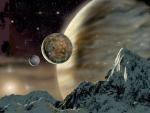 HD70642: A Star with Similar Planets
HD70642: A Star with Similar Planets
9.07.2003
Astronomers have discovered a planetary system more similar to our own Solar System than any known previously. The bright star HD70642, visible with binoculars toward the constellation of Puppis, was already known to be a star like our Sun.
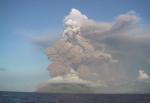 Mt Anatahan Erupts
Mt Anatahan Erupts
8.07.2003
Nobody suspected that this volcano would erupt. Mt. Anatahan has not erupted in recorded history. Nevertheless, on May 10, the small volcano in the Northern Mariana Islands of the western Pacific Ocean shot ash 10,000 meters into the air. Explosions from Mt. Anatahan continued every few minutes for two days.
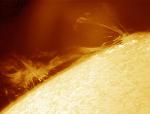 At the Edge of the Sun
At the Edge of the Sun
7.07.2003
Dramatic prominences can sometimes be seen looming just beyond the edge of the sun. A solar prominence is a cloud of solar gas held just above the surface by the Sun's magnetic field. The Earth would easily fit below the prominence on the left.
 Fractal Interstellar Dust Up Close
Fractal Interstellar Dust Up Close
6.07.2003
Our universe is a very dusty place. Dust usually shows its presence by blocking out light emitted from stars or nebulae behind it, sometimes creating the illusion of a horse's head or a sombrero hat. But nobody really knows what a typical interstellar dust grain looks like.
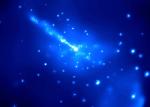 Centaurus A: X-Rays from an Active Galaxy
Centaurus A: X-Rays from an Active Galaxy
5.07.2003
Its core hidden from optical view by a thick lane of dust, the giant elliptical galaxy Centaurus A was among the first objects observed by the orbiting Chandra X-ray Observatory. Astronomers were not disappointed, as Centaurus A's appearance in x-rays makes its classification as an active galaxy easy to appreciate.
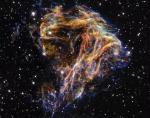 N49 s Cosmic Blast
N49 s Cosmic Blast
4.07.2003
Scattered debris from a cosmic supernova explosion lights up the sky in this gorgeous composited image based on data from the Hubble Space Telescope. Cataloged as N49, these glowing filaments of shocked gas span about 30 light-years in our neighboring galaxy, the Large Magellanic Cloud.
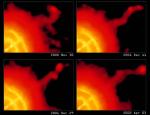 The Vela Pulsar s Dynamic Jet
The Vela Pulsar s Dynamic Jet
3.07.2003
The Vela pulsar is a neutron star born over 10,000 years ago in a massive supernova explosion. Above, false-color x-ray images from the Chandra Observatory reveal details of this remnant pulsar's x-ray bright nebula along with emission from a spectacular jet of high-energy particles.
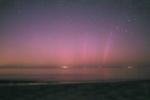 Aurora Over Cape Cod
Aurora Over Cape Cod
2.07.2003
Active pillars of colorful aurora were captured dancing over a serenely smooth and nearly colorless Cape Cod Bay last month. North is straight ahead so that the town lights near the center originate from Provincetown, Massachusetts, USA. The unusual red colors in the aurora slightly reflect off the ocean inlet.
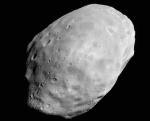 Martian Moon Phobos from MGS
Martian Moon Phobos from MGS
1.07.2003
Why is Phobos so dark? Phobos, the largest and innermost of two Martian moons, is the darkest moon in the entire Solar System. Its unusual orbit and color indicate that it may be a captured asteroid composed of a mixture of ice and dark rock.
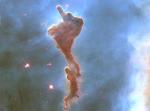 Disappearing Clouds in Carina
Disappearing Clouds in Carina
30.06.2003
This dense cloud of gas and dust is being deleted. Likely, within a few million years, the intense light from bright stars will have boiled it away completely. Stars not yet formed in the molecular cloud's interior will then stop growing.
|
January February March April May June July August September October November December |
|||||||||||||||||||||||||||||||||||||||||||||||||